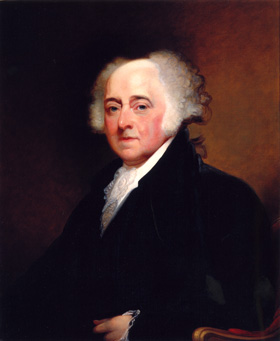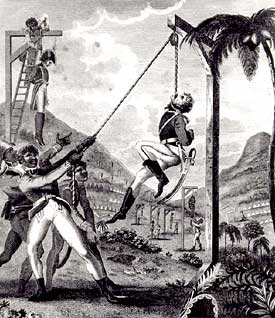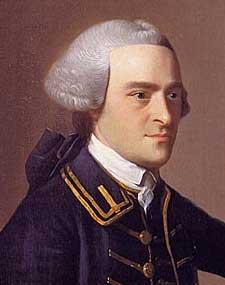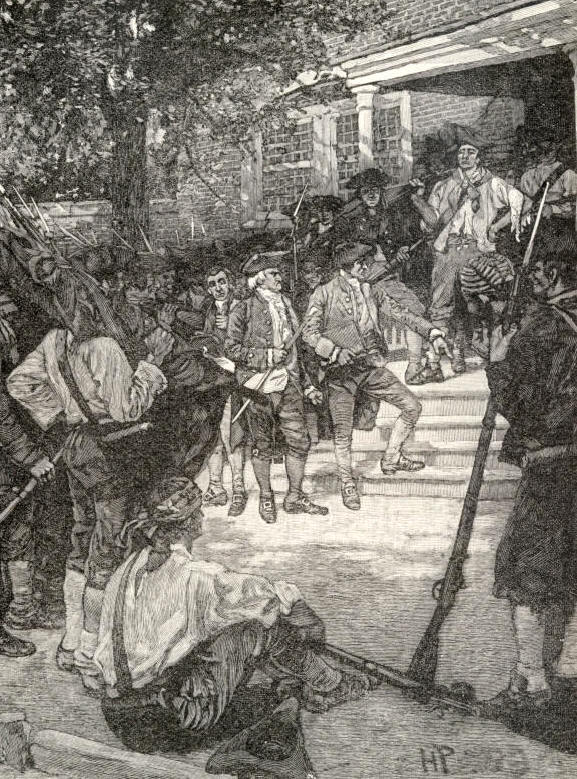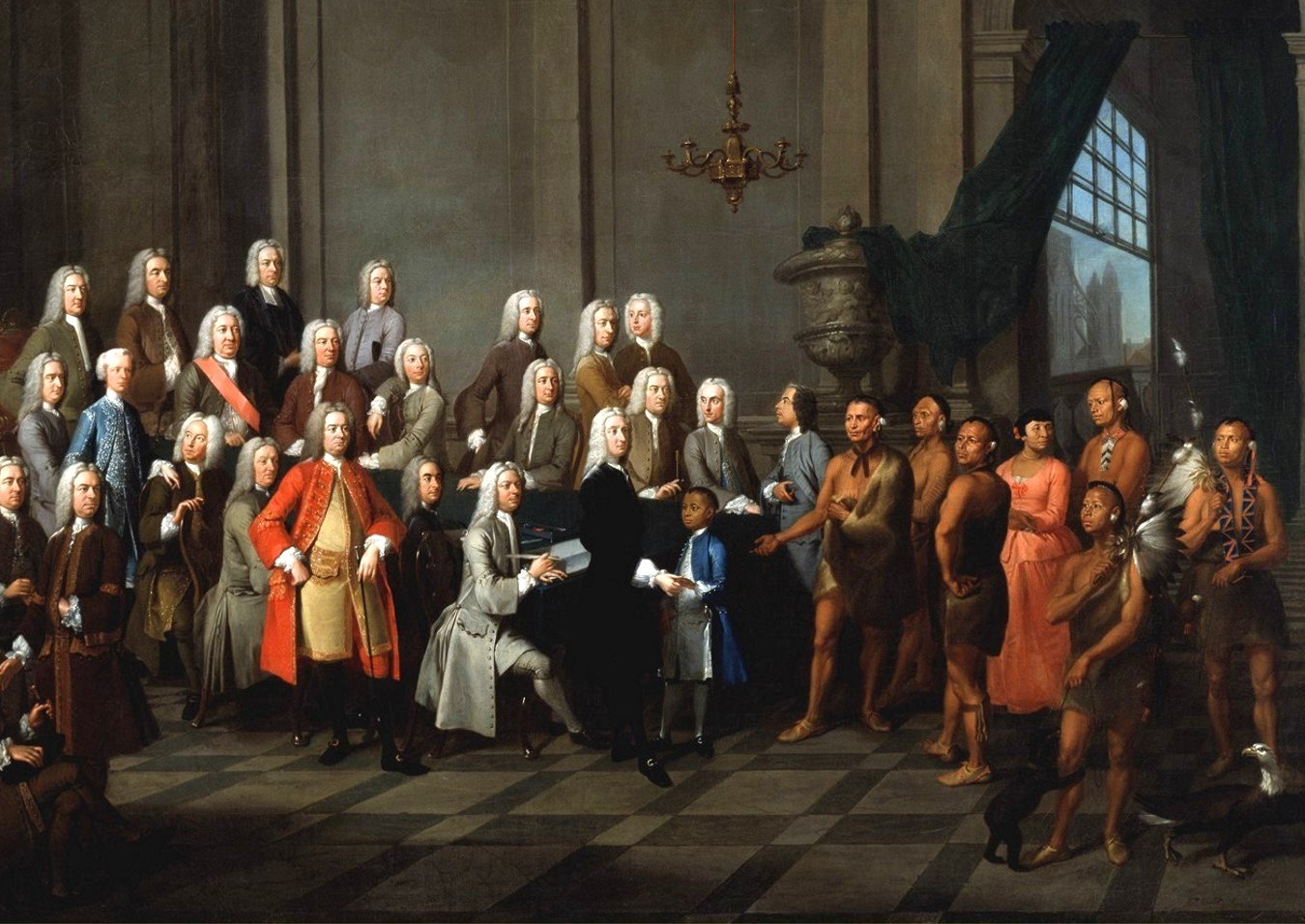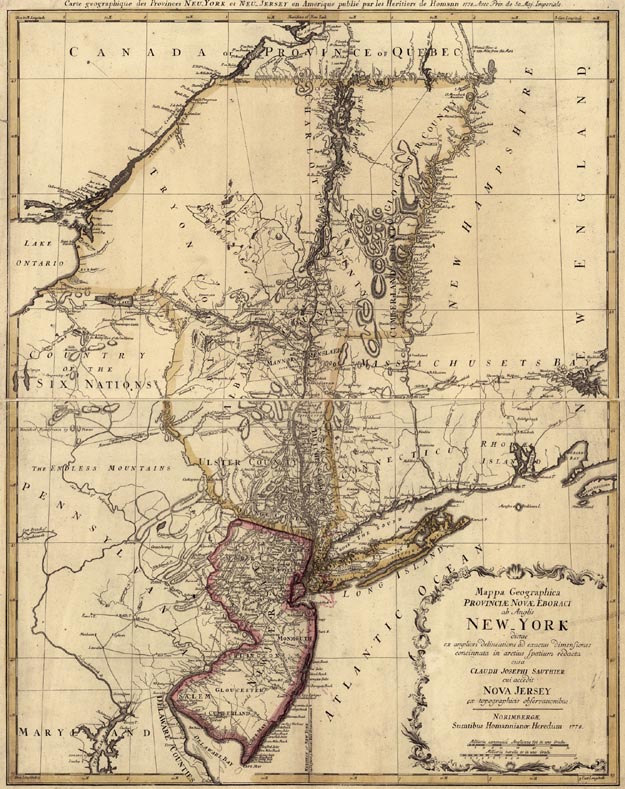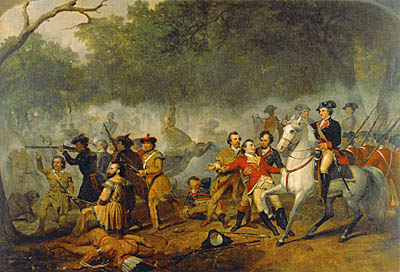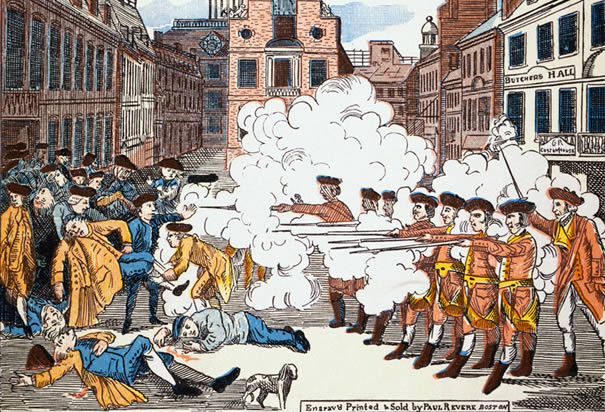I) Tories (Loyalists) – who were they?
A) Wealthy conservatives – men with money who felt threatened by the rhetoric of republican theory and the rise of the common man. Wealth Tories tended to remain loyal because they were doing well financially, usually because of their trade with Great Britain, and did not want to see any changes that affected that. Not all wealthy men were Tories, however; men who made a substantial amount of money from the smuggling trade, and whose economic well-being was adversely effected by the vigorous enforcement of duties, chose to become Whigs, or Patriots.
B) Oppositional culture – while generally one would associate oppositional culture (that is, the culture in opposition to the prevailing culture) with the Patriot cause, many poor and middle class people chose to remain loyal to the British crown because those men with money who ruled over them were Patriots.
1) Local politics – depending upon the politics of the local ruling group, many of the “lower sort” did choose their political affiliation based upon their opposition to the politics of the local ruling elite.
(a) New York – many lower sort Tories believed that they would be rewarded by the British government, like those tenant farmers on the Hudson Valley estate of Robert Livingston, Jr., who believed that they were going to be rewarded with “Pay from the Time of the Junction and each 200 Acres of Land,” and therefore signed a “King’s Book” promising to fight on behalf of the Crown. Militias put down this apostasy from neighboring towns, with somewhere between three to six tenants being killed, and nearly a hundred seriously injured. This belief that the King would reward their loyalty certainly undermined the wealthy Tory position.
(b) New Castle County Delaware – a mob of Tory refugees mobbed a Whig constable from his home and forced him to be whipped by an African American – a rather potent symbol in a slave state like Delaware (indeed, in any of the colonies, since slavery was legal in all of the colonies).
C) Non-white loyalists
1) Irish Catholics – very few Catholics supported the American Revolution, not because they opposed democratic reforms (although that was the case with the Catholic clergy), but because they were not welcomed within revolutionary circles (Patriots tended to be extremely anti-Catholic, and believed that Catholics, because of their alleged allegiance to the Pope, were incapable of republican government. Even in Maryland, founded by and for Catholics, the few Catholic landowners left in that colony tended to by Tories. The fact that the few Irish Catholics in the United States tended not to be seen as “white” is a story for another time (briefly explain the concept of “race”).
a. As with many such broad, sweeping statement, there are exceptions that prove the rule, since the most prominent Roman Catholic in the United States during the Revolutionary period was Charles Carroll, who was in fact a Patriot, signatory of the Declaration of Independence, and later Senator from Maryland.
2) African Americans – not all African Americans sided with the Loyalists, but nearly all slaves south of Pennsylvania did so—because they were promised freedom by the British government in return for their allegiance.
(a) Lord Dunmore – the royal governor of Virginia, whose personality created a number of enemies among the members of the House of Burgesses; when that legislative body voted for independence from Great Britain, Dunsmore retreated to a ship that sailed up and down the James River, creating havoc for planters who lived along the river. To create even more problems for Patriots in the colony, Lord Dunsmore issued a proclamation, with which he “freed” all slaves in the colony who fled their masters and joined the British Army (point out the portion of Jefferson’s Declaration of Independence that refers to this event).
(b) New York City – was under British control for almost the entire duration of the war; it became a haven for runaway slaves during the Revolution, many of who fled with the British when they finally retreated from the city in 1783.
3) Native Americans – again, not all Native Americans sided with the British (most, indeed, attempted to remain neutral), but few native peoples saw it in their best interests to fight alongside the Patriots. Most of the battles that Native Americans were involved in occurred in the so-called “frontier” areas, which were scenes of constant battles between natives and Euro Americans, anyway.
II) Patriots (Whigs) – like the Tories, Patriots could not be distinguished by occupation or social standing, although their decisions were often based upon economic decisions that they made in regard to their lives.
A) Wealthy “liberals” – people of wealth who had seen their economic successes threatened by this vigorous enforcement of tariffs generally sided with the Patriots.
B) Military militants – made up the core of the various state militias and the Continental Army. The majority of these men (and not a few women, who usually served a less than official capacity) served in these military units because of both an ideological commitment to the republican principles of the Revolution, and because they believed that these principles would serve their economic interests, as well.
1) “Summer Soldiers” – Thomas Paine’s rather derisive name for the various state militias, because they tended to fight in warm weather, when hardships were few—and after they had planted that year’s crops. The number of militiamen available to fight during any given period was difficult, a fact that exasperated the officers of the Continental Army.
(a) Philadelphia militia – is perhaps the epitome of both the strengths, and weaknesses, of the militias
(i) Committee of Privates – questioned the “rights” of the rich to rule over the poor; advocated that there be no distinction in the ranks, that poor militiamen and their families be provided for so that their service to their new country would not bring hardship to their families; the Committee of Privates was also the driving force behind the Pennsylvania constitution, which created a unicameral legislative body (no distinction in ranks) and a weak executive—this became the model for the national government created by the Articles of Confederation.
(ii) “Battle of Fort Wilson” – because the militia in Philadelphia was largely a political body (although they did see action when crossing the Delaware with Washington and in defending the city against British attack), the militia spent as much time agitating in the streets as they did in military maneuvers. The inflationary effects of war struck privates in the militia particularly hard, and the privates often took to the streets to protest against what they saw as profiteering by a few wealth merchants; one of these merchants, James Wilson, holed up in his house, where members of the militia found him, dragged him from his house, and threatened to tar and feather him; Wilson was saved by Joseph Reed, the president of Pennsylvania (at the head of the legislature), in a battle where five of the militiamen were killed and at least fourteen were wounded.
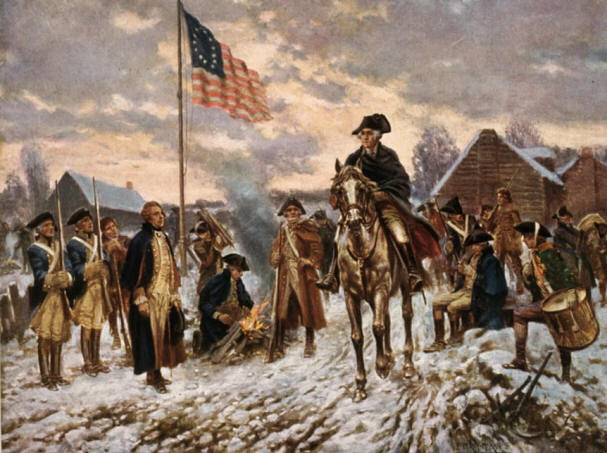
2) “Winter Soldiers” – the foots soldiers of the Continental Army, who suffered through most of the rigors of war, including two horrible winters, one near Morristown, New Jersey, and the other in Valley Forge, Virginia.
(a) Most of the foot soldiers in the Continental Army fought not for the ideology of the Revolution, but because of economic necessity. They were promised regular pay (something that they often times had to do without), and a bounty of land after serving a year or two in the army—a powerful incentive for the poor, who saw the way out of their condition access to cheap (or, in this case, “free”) land.
(b) Because the Continental Army was so ill supplied in the field, they were dependent upon their ability to “forage” for enough food and material to remain in the field; most of this foraging was done at the expense of farmers in the area where the Continental Army was encamped. Farmers were often given script as pay for the goods that the Army foraged from them; the fact that this script was often non-negotiable led to a great deal of resentment by those farmers so victimized, who saw their well-being threatened by a revolution that they might not support.
III) Why the Americans won – did the Americans “win” the war, or did the British forces lose?
A) Military prowess – did either side have this? The British forces were commanded by a succession of dandies, with little experience commanding an army in the field (particularly against an opponent which preferred to fight from behind rocks and trees in hunting shirts); yet the Continental Army itself only won a handful of battles (three of the largest in importance were the Battle of Saratoga, Cowpens, and the Battle of Yorktown, where the British Army was forced to surrender after a lengthy siege).
1) Defensive war – the Continental Army largely fought a defensive war, and used the fighting retreat to great effect
2) Lengthy supply lines – the British army, and its mercenaries, had to fight the war in hostile territory, an ocean away from its main base of supply. The British Army was only able to establish itself in the larger cities of the east coast; any other area that they briefly controlled was quickly taken back over by Patriot militias after the British Army pulled out.
B) Ideology – what part did ideology play in this war? Certainly, the foot soldiers had little ideological stake in the war; many fought as mercenaries (the Hessians, in particular, who were overrun early Christmas morning in Princeton after staying too long at the office Christmas party).
1) Declaration of Independence – how big a role did this document play in forming the ideology of the American Revolution?
IV) Articles of Confederation – because of the belief that the government which governed the best governed least, the government that was created by this document created a weak central government, one that was reliant upon the states for support and the money with which to run it.
A) Economic problems – a series of economic problems in the post-war era undermined support for the Articles of Confederation.
1) Inflation – the Continental dollar traded against the Spanish dollar at the rate of 3 to 1 in 1777, 40 to 1 in 1779, and 146 to 1 in 1781, by which time the Congress had issued more than $190 million in dollars. The tremendous increase in prices led to a great outcry, which state and local governments responded to this crisis with attempts at wage and price controls.
(a) Perceptions that the problems were caused by hoarding, and often mobs in towns “called” upon merchants suspected of hoarding—or worse, of price gouging—to demand that they sell their merchandise at “fair” prices; those who refused often (but not all of the time), had their merchandise removed and sold by others at a “fair” price.
2) Deflation – in the years immediately after the Revolutionary War, the fact that the new United States had few manufacturing industries, and continued to export raw materials and import finished goods, meant that the trade deficit continued to grow with the US’s largest trading partner, Great Britain.
(a) Currency drain – in order to pay for goods imported from Great Britain, US merchants had to pay in gold or silver, which meant that the supply in the US decreased
(b) Public debt – the deflationary spiral occurred at a time when the United States had a huge public debt to pay off from the money the government borrowed to finance the war; this meant that the money which was borrowed was even more expensive to pay back than had been anticipated.
B) Shays’ Rebellion – backcountry farmers became disenchanted with the lack of response on the part of the government, and began protesting and resisting the effects of economic disarray locally.
1) Closing courts – local courts had been throwing debtors who could not meet their debts into jail; local militia groups rallied and began marching on these courts and closing them—just as they had during the Revolutionary War period. With the courts not able to meet, they could not throw any more debtors into prison.
2) Action widespread – although the action in western Massachusetts gets most of the attention (this is were Daniel Shays and his compatriots operated), these same kinds of protests occurred at other places, as well. In fact, similar kinds of protests took place in every state in New England except Rhode Island (and not in Rhode Island because farmers had already captured control of the state government); a large scale protest involving over 200 people took place in one county in Maryland; near York, Pennsylvania, an auction whose proceeds were earmarked to pay off debt was halted by armed men. James Madison in Virginia claimed that officials in that state had on numerous occasions watched prisons, courthouses, and clerk offices burn because of the actions of large groups of people.
C) Aftermath – the climate that all of this conflict and uncertainty created made many people receptive to the idea that changes were necessary to the Articles of Confederation. A small coterie of political leaders were advocating greater centralized powers for government, although most American people, if opinion polls were taken at the time, would have opposed this.
V) Federal Constitution
A) Localism v. nationalism – in the years after the Revolutionary War, most Americans advocated the idea of localism over nationalism—that is, they closely identified themselves as residents of a specific locality (say, Boston or Baltimore) rather than as “Americans.” The further removed from locality that government became, for most Americans, the less loyalty that they felt towards that government (Civil War example—people like Robert E. Lee did not feel they were being disloyal towards the United States, but displaying loyalty toward their state, which had chosen to leave the Union; most northern supporters of the Union did so by volunteering to serve in their state militias, not in the Federal Army).
1) Fear of government power – most Americans feared a strong central government; after all, that the power of a strong central government had been one of the driving forces behind the Revolution.
2) Fear of government being too removed – the fear that a central government would be too far removed from the people to be responsive to those people (also one of the driving forces behind the Revolution).
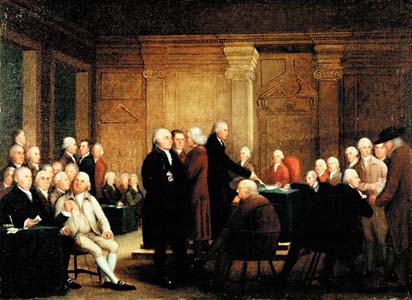
B) Annapolis Convention – representatives from several of the larger states (namely Virginia, Maryland, Pennsylvania, and New York) called on all of the states to send representatives to a convention in Annapolis to discuss the viability of the Confederation; with the exceptions of Rhode Island, Massachusetts, New Hampshire, and North Carolina, all of the states did so. At the Annapolis Convention it was decided that a convention of all the states would be called for May of 1787, “… to devise such further provisions as shall appear to them necessary to render the constitution of the Federal Government adequate to the exigencies of the Union; and to report such an Act for that purpose to the United States in Congress Assembled, as when agreed to, by them, and afterwards confirmed by the Legislatures of every state will effectually provide for the same.” (Alexander Hamilton, “Proceedings of the State Commissioners at Annapolis, Maryland, September 11-14, 1786”)
1) Authority – the call for the upcoming convention to meet in 1787 in Philadelphia was to make the necessary changes to the Articles of Confederation—not to create a new document of governance for the United States (discuss legality—which seems okay since this new document was sent back to the states for approval).
VI) Meeting at Philadelphia – the vaunted meeting at Philadelphia created a new instrument for governing which removed much of the direct control that voters had over their government
A) The Constitution and Elections – it is perhaps easiest to see how the new US Constitution subverted democracy by closely looking at how elections for officials were to be run. The only politicians directly elected by the people in this new federal government were in the House of Representatives; everyone else who held an elective office in the federal government was at best indirectly elected—so they were removed from being directly responsive to the people.
1) Election of representatives – every two years, directly elected by the people; number of representatives was to be determined by population.
2) Senate – two senators, chosen for a six-year term, and selected by the state legislature (and stayed that way until the 1910s). Not only are senators’ terms three times longer than representatives, but also the people they are to serve did not directly elect them.
3) President – four-year term, elected by the electoral college (people “pledged” to vote for a specific candidate, although they are allowed to change that vote); there has never been a popular election for the highest office in the land.
4) Supreme Court – completely “independent” (or, to put it another way, unaccountable to the American people), and they serve for life (or until they feel like retiring).
B) Checks and balances – in Madison’s scheme of things, the three branches of government were suppose to provide a check on the other’s powers, and keep one branch of government from overpowering the others—but did the “founding fathers” really see the three branches as equal partners in this endeavor?
1) Legislature – charged with the responsibility to make laws; this power, it is clear, was assumed by those responsible for creating the constitution, was assumed to be the greatest responsibility, so it is clear that the “founding fathers” intended Congress to be the senior partner in this governmental triad.
2) Executive – charged with enforcing the laws that the legislature makes; this office has probably witnessed the greatest change since its inception.
3) Judicial – to hear disputes arising under the Constitution; nowhere in the Constitution is the Supreme Court given the power to decide the constitutionality of a particular law—that power was assumed by the Court itself, and was unchallenged by Congress. Congress, in fact, has within its powers to take away this practice of judicial review by legislative fiat—but in practice that right is rarely used.
C) Bill of Rights – was reluctantly acceded to by early Federalists in order to quell fears of both friends and foes of the new Constitution; Madison and Hamilton both claimed that no “bill of rights” was necessary, since all rights not explicitly claimed in the Constitution remained safe for individuals and the states.
1) Second Amendment “A well regulated Militia, being necessary to the security of a free state, the right of the people to keep and bear arms, shall not be infringed.” Does this guarantee the rights of individuals to keep guns, or the right of states to have militias?
2) Fifth Amendment – the right not to self-incriminate (a valuable commodity for Enron executives these days.
D) The Whisky Rebellion – backcountry farmers viewed this tax on grain (it was cheaper for them to transport the grain they had to sell as liquor than in bulk) as an unreasonable tax, which they refused to pay—as their fathers in the Revolutionary generation had refused to pay unreasonable taxes. George Washington used his powers as President to call up 13,000 federal troops (more than he himself had ever commanded in the Continental Army) to round up these tax evaders. A few were eventually found, and brought to Philadelphia for trial; two who were found guilty of treason eventually received presidential pardons.


